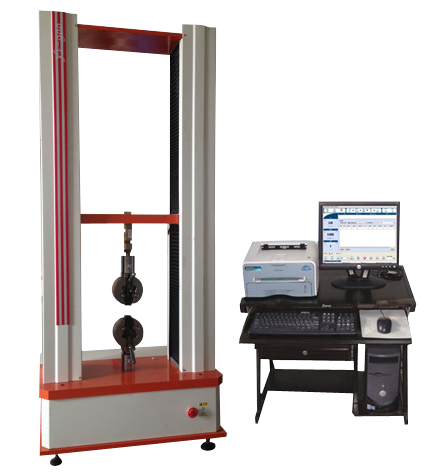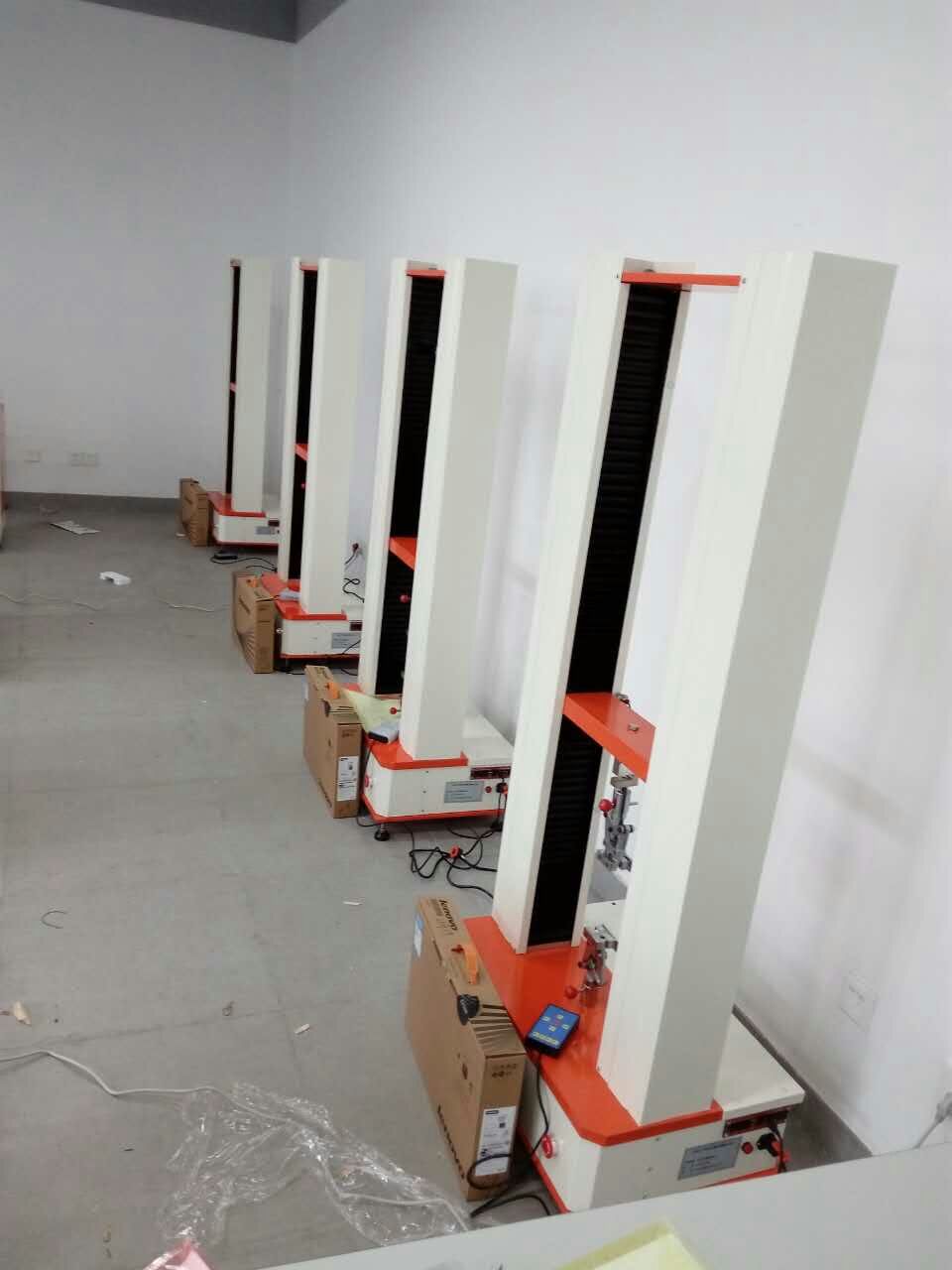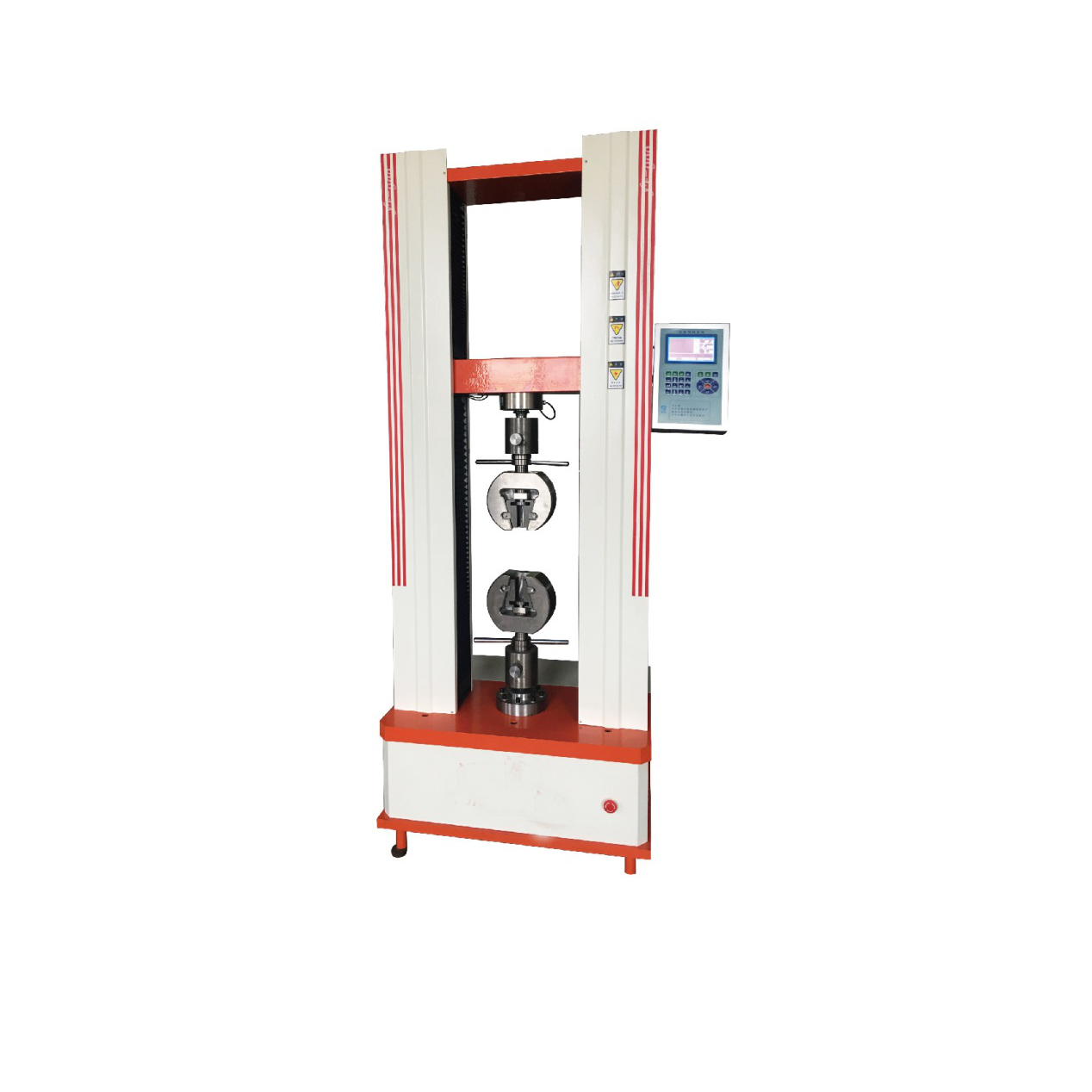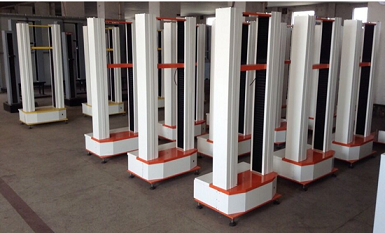

價(jià)格:38450元瀏覽:186次聯(lián)系:劉元元 / 15132636097 / 企業(yè):北京北廣精儀儀器設(shè)備有限公司留言店鋪收藏
數(shù)顯電子拉力試驗(yàn)機(jī) 主要特點(diǎn):
采用進(jìn)口光電編碼器進(jìn)行位移測(cè)量,控制器采用嵌入式單片微機(jī)結(jié)構(gòu),內(nèi)置功能強(qiáng)大的測(cè)控軟件,集測(cè)量、控制、計(jì)算、存儲(chǔ)功能于一體。具有自動(dòng)計(jì)算應(yīng)力、延伸率(需加配引伸計(jì))、抗拉強(qiáng)度、彈性模量的功能,自動(dòng)統(tǒng)計(jì)結(jié)果;自動(dòng)記錄醉大點(diǎn)、斷裂點(diǎn)、指定點(diǎn)的力值或伸長(zhǎng)量;采用計(jì)算機(jī)進(jìn)行試驗(yàn)過(guò)程及試驗(yàn)曲線的動(dòng)態(tài)顯示,并進(jìn)行數(shù)據(jù)處理,試驗(yàn)結(jié)束后可通過(guò)圖形處理模塊對(duì)曲線放大進(jìn)行數(shù)據(jù)再分析編輯,并可打印報(bào)表。
數(shù)顯電子拉力試驗(yàn)機(jī)適用范圍:
廣泛應(yīng)用于電線電纜、紡織物、防水材料、無(wú)紡布、安全帶、橡膠、塑料、薄膜、鋼絲繩、鋼筋、金屬絲、金屬箔、金屬板材和金屬棒絲等金屬材料和非金屬材料及零部件產(chǎn)品進(jìn)行拉伸、壓縮、彎曲、撕裂、90?剝離、180?剝離、剪切、粘合力、拔出力、延伸伸長(zhǎng)率等試驗(yàn),以及一些產(chǎn)品的特殊力學(xué)性能試驗(yàn)。
Main features:
The imported photoelectric encoder is used for displacement measurement. The controller adopts embedded single chip microcomputer structure and built-in powerful measurement and control software, which integrates measurement, control, calculation and storage functions. With automatic calculation of stress, elongation (need to add extension meter), tensile strength, elastic modulus function, automatic statistics results; Automatically record the force value or elongation of large points, breaking points and designated points; The dynamic display of the test process and the test curve is carried out by computer, and the data is processed. After the test, the curve can be amplified and the data can be analyzed and edited by the graph processing module, and the report can be printed.
Scope of application:
Widely used in wire and cable, textile, waterproof material, non-woven fabric, safety belt, rubber, plastic, film, wire rope, steel bar, metal wire, metal foil, metal sheet and metal rod wire and other metal materials and non-metal materials and parts products for stretching, compression, bending, tearing, 90?peel, 180?peel, shear, adhesive force, drawing force, elongation elongation And the special mechanical properties of some products.
組成: | |
拉力材料試驗(yàn)機(jī)是由測(cè)量系統(tǒng)、驅(qū)動(dòng)系統(tǒng)、控制系統(tǒng)及電腦(電腦系統(tǒng)型拉力試驗(yàn)機(jī))等結(jié)構(gòu)組成。 | |
技術(shù)參數(shù)規(guī)格: | |
醉大試驗(yàn)力(kN) | 5kN |
試驗(yàn)機(jī)測(cè)量精度 | 1級(jí)(標(biāo)準(zhǔn)版) |
有效測(cè)力范圍 | 2%-100%FS/ |
分 辨 力 | 1/300000 |
示值相對(duì)誤差 | ?1% |
速度調(diào)節(jié)范圍 | 0.05~500mm/min (無(wú)級(jí)調(diào)速) |
準(zhǔn)確度 | 優(yōu)于示值的?1% |
力控速率控制范圍 | 0.05—5%FN |
測(cè)量范圍 | 0~999mm |
分辨率 | 0.001mm |
測(cè)量精度 | 優(yōu)于示值的?1% |
重量 | 150KG |
控制系統(tǒng)
顧名思義,就是控制試驗(yàn)機(jī)運(yùn)作的系統(tǒng),人們通過(guò)操作臺(tái)可以控制試驗(yàn)機(jī)的運(yùn)作,通過(guò)顯示屏可以獲知試驗(yàn)機(jī)的狀態(tài)及各項(xiàng)試驗(yàn)參數(shù),若該機(jī)帶有電腦的話,也可以由電腦實(shí)現(xiàn)各項(xiàng)功能并進(jìn)行數(shù)據(jù)處理分析、試驗(yàn)結(jié)果打印。試驗(yàn)機(jī)同電腦之間的通信一般都是使用RS232串行通信方式,它通過(guò)計(jì)算機(jī)背后的串口(COM號(hào))進(jìn)行通信,此技術(shù)比較成熟、可靠,使用方便。
開(kāi)關(guān)機(jī)注意事項(xiàng):
1開(kāi)機(jī)時(shí)主機(jī)和計(jì)算機(jī)的開(kāi)機(jī)順序會(huì)影響計(jì)算機(jī)的通訊初始化設(shè)置,所以務(wù)必請(qǐng)用戶嚴(yán)格按照上述開(kāi)機(jī)順序進(jìn)行。
2每次開(kāi)機(jī)后要預(yù)熱5分鐘,待系統(tǒng)穩(wěn)定后,才可進(jìn)行試驗(yàn)工作。
3如果剛剛開(kāi)機(jī),需要再開(kāi)機(jī),至少保證1分鐘的間隔時(shí)間。
4在更換夾具后,首先要注意調(diào)整好可調(diào)擋圈(上下限位開(kāi)關(guān))。
5尤其在用小力值傳感器做試驗(yàn)時(shí),一定要調(diào)整好可調(diào)擋圈的位置,以免操作失誤而損壞小力值傳感器。不要超過(guò)傳感器的額定量程。
6任何時(shí)候都不能帶電插撥電源線,否則很容易損壞電氣控制部分。
7試驗(yàn)過(guò)程中,不能遠(yuǎn)離試驗(yàn)機(jī)。
8試驗(yàn)過(guò)程中,除停止按鍵和急停開(kāi)關(guān)外,不要按控制盒上的其它按鍵,否則會(huì)影響試驗(yàn)。
9試驗(yàn)結(jié)束后,一定要關(guān)閉所有電源。
10本計(jì)算機(jī)是專(zhuān)門(mén)用于試驗(yàn)機(jī)控制和數(shù)據(jù)處理的,請(qǐng)勿在計(jì)算機(jī)內(nèi)安裝其它應(yīng)用軟件,以免試驗(yàn)機(jī)應(yīng)用軟件不能正常運(yùn)行。
11計(jì)算機(jī)要嚴(yán)格按照系統(tǒng)要求一步一步退出,正常關(guān)機(jī),否則會(huì)損壞部分程序,導(dǎo)致軟件無(wú)法正常使用。
12不要使用來(lái)歷不明或與本機(jī)無(wú)關(guān)的軟盤(pán)在試驗(yàn)機(jī)控制用計(jì)算機(jī)上寫(xiě)盤(pán)或讀盤(pán),以免病毒感染。
Note on and off:
1 The boot order of the host and the computer will affect the communication initialization Settings of the computer, so be sure to strictly follow the above boot order.
2 Preheat for 5 minutes after each startup, and test work can be carried out only after the system is stable.
3 If you have just started the machine and need to start it again, ensure that the interval is at least 1 minute.
4 After replacing the fixture, first pay attention to adjusting the adjustable stop ring (upper and lower limit switch).
5 Especially when testing with a small force value sensor, it is necessary to adjust the position of the adjustable stop ring to avoid damage to the small force value sensor due to misoperation. Do not exceed the rated range of the sensor.
6 Do not plug or dial the power cord at any time, otherwise it is easy to damage the electrical control part.
7 During the test, do not stay away from the testing machine.
8 During the test, except for the stop button and the emergency stop switch, do not press other keys on the control box, otherwise it will affect the test.
9 After the test, be sure to turn off all power supplies.
This computer is specially used for testing machine control and data processing, do not install other application software in the computer, so as to avoid the normal operation of the testing machine application software.
11 The computer must exit step by step in strict accordance with the system requirements and shut down normally. Otherwise, some programs will be damaged and the software cannot be used normally.
12 Do not use floppy disks of unknown origin or unrelated to the machine to write or read disks on the test machine control computer to avoid virus infection.
安全帶拉力試驗(yàn)機(jī)、安全帶拉伸強(qiáng)度試驗(yàn)機(jī)、安全繩拉力試驗(yàn)機(jī)、安全繩拉伸強(qiáng)度試驗(yàn)機(jī)、電子拉力試驗(yàn)機(jī)
結(jié)構(gòu)特征及工作原理
本機(jī)由機(jī)械、電氣二大部分組成(見(jiàn)附圖)。
1機(jī)械部分結(jié)構(gòu)及工作原理:
本機(jī)采用電動(dòng)加載方式,底部是整機(jī)結(jié)構(gòu)承載支架,內(nèi)部包含有電機(jī)驅(qū)動(dòng)器、加載電機(jī)、減速機(jī)構(gòu)、動(dòng)力傳動(dòng)機(jī)構(gòu)等部件;上部是試樣夾持及力值、位移測(cè)量機(jī)構(gòu),包含有試樣拉伸夾具、測(cè)力傳感器、位移傳感器等主要部件。
2 電氣部分:
電氣部分由顯示測(cè)量控制部分組成。顯示測(cè)量控制部分實(shí)現(xiàn)各種控制、顯示、數(shù)據(jù)采集、處理等功能。軟件部分的操作請(qǐng)仔細(xì)閱讀《軟件說(shuō)明書(shū)》。
3 本機(jī)的幾項(xiàng)主要功能:
3.1 全開(kāi)放性參數(shù)設(shè)置
3.2 設(shè)置參數(shù)保存
3.3 浮動(dòng)零點(diǎn)設(shè)置,可隨時(shí)調(diào)整零點(diǎn)
3.4 峰值保持及存儲(chǔ),常值跟隨;
3.5 在有效速度范圍內(nèi),速度值任意設(shè)置;
3.6 橫梁移動(dòng)過(guò)程中的速度快捷切換功能
3.7 靈活的數(shù)據(jù)查詢顯示功能;
3.8 過(guò)載停機(jī)保護(hù)功能;
3.9 試驗(yàn)結(jié)束自動(dòng)判斷功能;
3.10 極限位置保護(hù)等;

常見(jiàn)故障及排除
故障現(xiàn)象 | 原因及處理 |
開(kāi)機(jī)后無(wú)顯示 | 控制器電源線,保險(xiǎn),開(kāi)關(guān)等 |
啟動(dòng)不動(dòng)作 | 主機(jī)電源,保險(xiǎn),開(kāi)關(guān),控制連接線 |
加載后,試驗(yàn)力沒(méi)有顯示 | 傳感器是否連接好 |
力值穩(wěn)定 | 檢查系統(tǒng)接地線 |
橫梁移動(dòng)后沒(méi)有變形 | 變形傳感器是否連接 |
試驗(yàn)力顯示大化 | 傳感器超量程加載或傳感器線斷 |
打印機(jī)無(wú)動(dòng)作 | 檢查是否配備打印機(jī),打印機(jī)連線 |
經(jīng)過(guò)以上排查,還不能排除設(shè)備故障,請(qǐng)及時(shí)撥打我公司售后服務(wù)熱線電話,由我公司專(zhuān)業(yè)技術(shù)人員協(xié)助解決,嚴(yán)禁用戶私自打開(kāi)設(shè)備進(jìn)行維修,若私自打開(kāi)設(shè)備進(jìn)行維護(hù),一切后果我公司不承擔(dān)任何責(zé)任
Common faults and troubleshooting
The cause and treatment of the occurrence of the disorder
There is no display of controller power cord, safety, switch, etc
Start no action host power, safety, switch, control cable
After loading, the test force does not show whether the sensor is properly connected
Force stability Check the system grounding cable
The beam is not deformed after moving. Whether the deformation sensor is connected
The test force shows that the sensor is overloaded or the sensor line is broken
Printer No action Check whether the printer is equipped and connected
After the above investigation, still can not eliminate the equipment fault, please call our company's after-sales service hotline in time, by our company's professional and technical personnel to help solve, users are strictly prohibited to open the equipment for maintenance, if privately opened the equipment for maintenance, my company does not bear any responsibility for all consequences
維修保養(yǎng)方法及注意事項(xiàng):
1、機(jī)臺(tái)部份,外表經(jīng)常擦拭,保持清潔。
2、電鍍部份請(qǐng)以機(jī)油擦拭,以防止生銹宜保光亮。
3、動(dòng)力螺桿及螺桿部份請(qǐng)加潤(rùn)滑油,以保傳動(dòng)靈敏。(潤(rùn)滑油采黃油加入少許機(jī)油混合即可)。
4、面板(控制箱即顯示器)請(qǐng)用乾布擦拭,嚴(yán)防沾水,以免損壞IC電子零件。
5、各項(xiàng)治具及接頭配件請(qǐng)妥置,并擦拭防銹油,以防生銹。
6、上下班必需把電源關(guān)掉。
測(cè)試項(xiàng)目:(普通顯示值及計(jì)算值)
★拉伸應(yīng)力 ★拉伸強(qiáng)度
★扯斷強(qiáng)度 ★扯斷伸長(zhǎng)率
★定伸應(yīng)力 ★定應(yīng)力伸長(zhǎng)率
★定應(yīng)力力值 ★撕裂強(qiáng)度
★任意點(diǎn)力值 ★任意點(diǎn)伸長(zhǎng)率
★抽出力 ★粘合力及取峰值計(jì)算值

(一)普通測(cè)試項(xiàng)目:(普通顯示值及計(jì)算值)
●拉伸應(yīng)力 ●拉伸強(qiáng)度 ●扯斷強(qiáng)度 ●扯斷伸長(zhǎng)率
●定伸應(yīng)力 ●定應(yīng)力伸長(zhǎng)率 ●定應(yīng)力力值 ●撕裂強(qiáng)度
●任意點(diǎn)力值 ●任意點(diǎn)伸長(zhǎng)率 ●抽出力 ●粘合力及取峰值計(jì)算值
●壓力試驗(yàn) ●剪切剝離力試驗(yàn) ●彎曲試驗(yàn) ●拔出力穿刺力試驗(yàn)
(二)特殊測(cè)試項(xiàng)目:
1.彈性系數(shù)即彈性楊氏模量定義:同相位的法向應(yīng)力分量與法向應(yīng)變之比。為測(cè)定材料剛性之系數(shù),其值越高,材料越強(qiáng)韌。
2.比例限:荷重在一定范圍內(nèi)與伸長(zhǎng)可以維持成正比之關(guān)系,其醉大應(yīng)力即為比極限。
3.彈性限:為材料所能承受而不呈永久變形之醉大應(yīng)力。
4.彈性變形:除去荷重后,材料的變形完全消失。
5.永久變形:除去荷重后,材料仍殘留變形。
6.屈服點(diǎn):材料拉伸時(shí),變形增快而應(yīng)力不變,此點(diǎn)即為屈服點(diǎn)。屈服點(diǎn)分為上下屈服點(diǎn),一般以上屈服點(diǎn)作為屈服點(diǎn)。屈服(yield):荷重超過(guò)比例限與伸長(zhǎng)不再成正比,荷重會(huì)突降,然后在一段時(shí)間內(nèi),上下起伏,伸長(zhǎng)發(fā)生較大變化,這種現(xiàn)象叫作屈服。
7.屈服強(qiáng)度:拉伸時(shí),永久伸長(zhǎng)率達(dá)到某一規(guī)定值之荷重,除以平行部原斷面積,所得之商。
8.彈簧K值:與變形同相位的作用力分量與形變之比。
9.有效彈性和滯后損失:在復(fù)合材料拉力試驗(yàn)機(jī)上,以一定的速度將試樣拉伸到一定的伸長(zhǎng)率或拉伸到規(guī)定的負(fù)荷時(shí),測(cè)定試樣收縮時(shí)恢復(fù)的功和伸張時(shí)消耗的功之比的百分?jǐn)?shù),即為有效彈性;測(cè)定試樣伸長(zhǎng)、收縮時(shí)所損失的能與伸長(zhǎng)時(shí)所消耗的功之比的百分?jǐn)?shù),即為滯后損失。
Test items: (common display value and calculated value)
★ Tensile stress ★ tensile strength
★ Tensile strength ★ tensile elongation
★ Constant elongation stress ★ constant elongation
★ Constant stress force value ★ Tear strength
★ Arbitrary point force value ★ arbitrary point elongation
★ Extraction force ★ Adhesive force and take the peak value of calculation
(1) Common test items: (common display value and calculated value)
● Tensile stress ● Tensile strength ● Tensile strength ● elongation at break
● Constant elongation at constant stress ● Constant stress force value ● Tearing strength
● Arbitrary point force value ● arbitrary point elongation ● Withdrawal force ● Adhesive force and take the peak calculated value
● Pressure test ● Shear stripping force test ● Bending test ● Extraction force puncture force test
(2) Special test items:
1. Elastic coefficient is defined as elastic Young's modulus: the ratio of normal stress component and normal strain in the same phase. To determine the coefficient of material rigidity, the higher the value, the stronger the material.
2. Proportional limit: the load can be maintained in direct proportion to the elongation within a certain range, and the large stress is the ratio limit.
3. Elastic limit: the great stress that the material can withstand without permanent deformation.
4. Elastic deformation: After removing the load, the deformation of the material completely disappears.
5. Permanent deformation: After removing the load, the material remains deformed.
6. Yield point: When the material is stretched, the deformation increases and the stress remains unchanged, which is the yield point. Yield points are divided into upper and lower yield points, and generally the above yield points are used as yield points. yield: the load exceeding the proportional limit is no longer proportional to the elongation, the load will drop suddenly, and then over a period of time, up and down, and the elongation will change greatly, this phenomenon is called yield.
7. Yield strength: when stretching, the load of permanent elongation reaching a specified value is divided by the original fault area of the parallel part.
8. Spring K value: the ratio of the force component in phase with deformation to deformation.
9. Effective elasticity and hysteresis loss: In the composite tensile test machine, when the sample is stretched to a certain elongation or stretched to a specified load at a certain speed, the percentage of the ratio of the work recovered when the sample is contracted and the work consumed when stretched is measured, that is, the effective elasticity; The percentage of the ratio between the energy lost during the elongation and contraction of the sample and the work consumed during the elongation is the hysteresis loss.
業(yè)務(wù)咨詢:932174181 媒體合作:2279387437 24小時(shí)服務(wù)熱線:15136468001 盤(pán)古機(jī)械網(wǎng) - 全面、科學(xué)的機(jī)械行業(yè)免費(fèi)發(fā)布信息網(wǎng)站 Copyright 2017 PGJXO.COM 豫ICP備12019803號(hào)